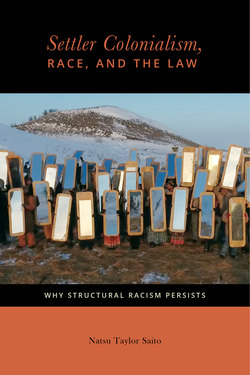Читать книгу Settler Colonialism, Race, and the Law - Natsu Taylor Saito - Страница 45
На сайте Литреса книга снята с продажи.
Indians as Anachronism
ОглавлениеThe final strategy of conceptual disappearance considered here is the consignment of Indigenous peoples to a different time rather than space; a construction so pervasive that even today American Indians are almost always discussed by non-Indigenous people in the past tense. As part of the past, they cannot exist in the present; in Wolfe’s words, the “primary effect” of defining “authentic” indigeneity “as a frozen precontact essence . . . is to provide a formula for disqualification.”131 This can be seen in the common social practice of presuming that someone is or is not “really” Indian based on stereotypes about what Indians should look like, or how they should act.132
To the extent Indigenous realities reflect such imagery, the settler narrative deems them to be vestiges of a prior era that, for better or worse, is now irrelevant. When Indigenous people do not conform to the stereotypes, they are ignored as not-really-Indian. This construction of the-Indian-as-anachronism (a practice Veracini terms “narrative transfer”) serves to render Indigenous peoples—and their claims—invisible in contemporary settler society. They may exist as individuals, but their “Indian-ness” is not allowed to intrude into the present.
In one contemporary example, Mike Taylor, an American Indian blogger, explained that he had taken down his Facebook page after discovering that his White “friends” overwhelmingly believed that he “lived in the past” and needed to “get over” it, apparently because about 15 percent of his posts addressed Indigenous issues.133 Noting that virtually all of these posts discussed current tribal issues or upcoming events, Taylor concluded that the real problem was that these contemporary reminders of “our very existence” constituted “an unpleasant reminder . . . that Turtle Island is not their land.”134 In other words, just as the settlers in the Southeast found the Cherokees too civilized and, therefore, likely to be permanent, the dominant narrative resists the injection of Indian-ness into the present not because Indigenous people are living in the past, but because they should be. This framing serves to alleviate settler guilt, for if real Indians exist(ed) only in the past, nothing needs to be done in the present. More insidiously, it facilitates the repression of resistance, for, as Veracini observes, when Indigenous peoples’ “defeat is irretrievably located in the past, their activism in the present is [rendered] illegitimate.”135
